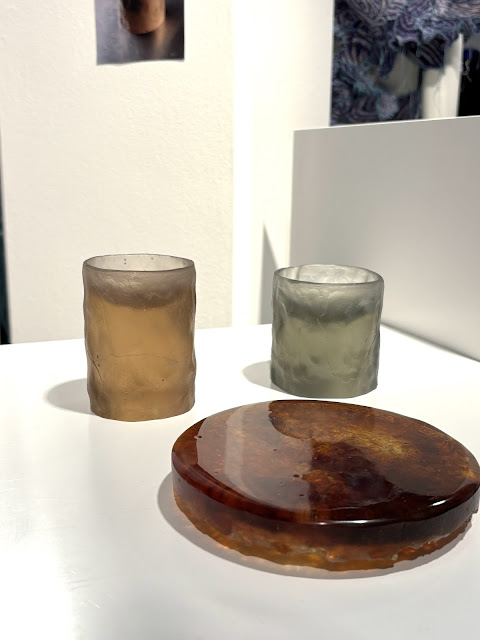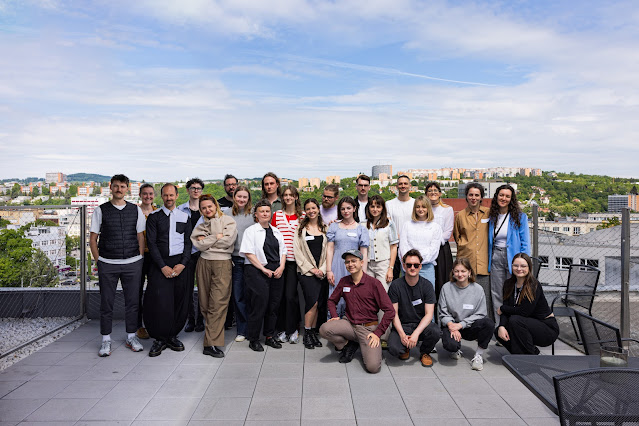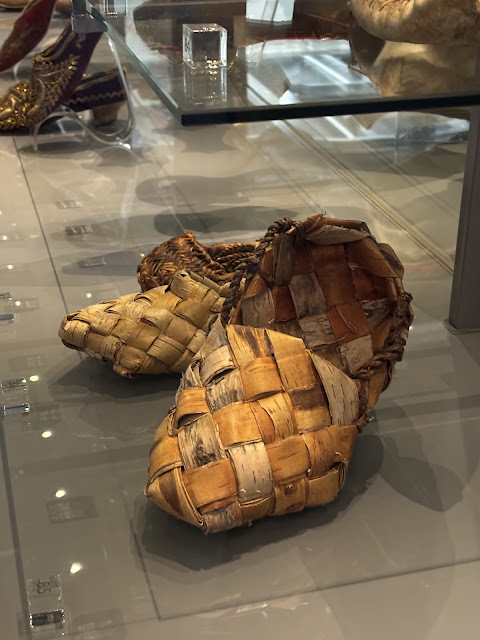 |
| Paweł Kaźmierowski |
Every May, since several yars in a row, I find myself drawn back to Zlín Design Week—not just for the programme, but for its welcoming and generous spirit. This year marked the 11th edition, hosted once again by the Faculty of Multimedia Communications at UTB. What sets Zlín apart isn’t only the current curatorial eye but also the atmosphere of true support for young designers and the genuine invitation to exchange. This year, the festival was threaded through with the theme DIALOGUE, not just as a slogan but as a structure: open formats, outdoor happenings, and spaces built to encourage encounter rather than spectacle.
Best in Design 2025 – From Spectacle to Soil
I had the honour of returning as a jury member for the Best in Design competition in the fashion category, alongside
Katarína Mydliarová and Rafał Zakrzewski—both past finalists and winners in previous editions of this festival. With over 540 applications from 25 countries, it was no easy task for the jury to select top 10 for each category and appoint the top three.
This year, the Best in Design Award Ceremony took place in the Congress Center Zlín, a venue that elevated the evening with its architectural elegance.
 |
| Daria Dembická |
The fashion category’s first prize went to
Daria Dembická for her vibrant and technically audacious collection Sweet Decadence. Inspired by the theatrical world of musicals, dance and burlesque, Daria blurs the boundary between accessory and prop. Her pieces morph between functions—footwear becomes sculpture, ornament becomes gesture—executed through a combination of 3D printing, silver casting and metalwork. The result is a collection that stages its own miniature drama on the body, decadent and precise.
Second place went to
Paweł Kaźmierowski for Childhood Dreams Unleashed, a tender and bold revisiting of childhood fascinations once buried under gender norms. His designs play with form and fantasy, turning personal memory into a wearable world. There’s therapy in this work—emotional archaeology calling for embracing individual identity through fashion.
Third place was awarded to the duo
Eliška Gogolová & Bára Tetaurová for their speculative project Nourish Your Body and Soil. Beginning with the overlooked potential of local sheep wool, the designers crafted a garment that doubles as a carrier of beneficial soil microbiomes—a suit that heals the skin while reconnecting the wearer to the land. They later extended the concept into gardening gloves, turning speculative fashion into applied sustainability. Their work gently challenges us to think about clothing as symbiotic, as alive.
The overall Grand Prix of Best in Design 2025 went to
Dalibor Itze for his redesign of Slovak Railways. With great clarity, Dalibor tackled an infrastructural giant, proposing a coherent and accessible visual identity that enhances passenger orientation and accessibility—including for the visually impaired. This project demonstrates that design isn't just an aesthetic tool, but a civic act.
The Product & Industrial Design, Service Design, and Communication Design categories presented equally compelling explorations of how design shapes our material and social environments.
 |
| Ivo Jedlička |
In Product & Industrial Design, Ivo Jedlička claimed first place with Cooking the Craft—a thoughtful and tactile reimagining of culinary tools that repositions cooking as both a craft and a ritual. His pieces bridge material intelligence and poetic simplicity, echoing traditional forms while looking toward a slower, more considered future of domesticity.
Second place was awarded to Agnieszka Bujas for Home Care for the Newborn and Mother During the Postpartum Period. Her project takes on an often-overlooked chapter of life with sensitivity, offering objects that support emotional and physical recovery while championing the intimacy of early motherhood.
Tímea Kepová received third place for the UP AND DOWN Collection, a furniture series that considers human movement and interaction, playing with height and flexibility to create pieces that respond to changing postures and needs—design as dialogue with the body.
In the Service Design category, the international team of Lucia Natalia Perez Gonzalez, Alice Chapman, Shubhangi Shubhangi, and Olivia Cederquist won first place with Creative Currents—an initiative that uses cultural production as a medium for social change. Their project models how design can become a participatory tool for community empowerment.
Second place went to Karolína Menclerová for After Trash, a speculative yet actionable concept addressing waste systems and our emotional relationships with objects after disposal. It's a thoughtful examination of what happens when we let go—and how design might intervene in the afterlife of things.
Third place was awarded to Lars Sorger and Claudius Pudel for Frozen Research, a haunting and precise project that addresses preservation—of data, knowledge, and memory—within extreme environments. A reminder that design must also think in long timelines, across climates and crises.

In
Communication Design, the first prize went to
Dalibor Itze for his Slovak Railways redesign, also winner of the overall Grand Prix. His work exemplifies clarity, usability, and civic responsibility—graphic design as a public service.
Second place was awarded to
Michaela Zdeňková for Fight FGM/C Together, a powerful visual campaign that addresses female genital mutilation and cutting through strong, urgent, and sensitive design. It communicates with care, never losing sight of the people behind the statistics.
Third place went to
Ina Dubavy for Digital Garden of Endangered Plant Species in the Czech Republic, an evocative and informative online archive that renders botanical knowledge into immersive digital storytelling. A poetic intersection of data and design.
These projects show that the next generation of designers is not only technically skilled and conceptually ambitious—but deeply attuned to the urgencies of the world they are inheriting. Whether addressing ecological collapse, care work, cultural erasure or public infrastructure, they propose design not as decoration, but as intervention.
One of my favourite moments wasn’t on stage but during the day-long
networking programme that brought together all finalists and jury members. We drew, exchanged and collided through a playful series of workshops designed to facilitate conversations and collaborations. These in-between moments are where the value of a platform like Zlín reveals itself.
I also had the opportunity to contribute a lecture titled
“Curating Fashion as Cultural & Ethical Practice,” in which I spoke about the importance of curating fashion not only through visual aesthetics but as a discursive and ethical gesture—shaping stories, values and formats of presentation that reflect our contemporary condition. I based this on my own practice and concrete projects realized within the context of FASHIONCLASH.
.jpg) |
| photo by @okunkova_ |
This year, the networking also invited us into Zlín’s rich cultural and industrial heritage. In the afternoon, we visited the exhibition
“The Bata Principle”, a fascinating dive into the city's shoemaking legacy, the rise of the Zlín film studios, and the far-flung journeys of famous Czechoslovak explorers. The tour ended with a visit to the Baťa Skyscraper, where we took in a panoramic view of the city that continues to shape and be shaped by design.
Fashion Show as Experience
 |
| Barbara Rakovská |
Friday evening’s Fashion Show programme took on a new form this year—a close-up, immersive experience where visitors could encounter the designers’ work in motion and in intimacy. Instead of distance and flash, the format invited proximity and observation.
Among the featured designers was
Roniqveja, the raw and romantic design duo of Nikola Kovářová and Adam Vejtasa. Their collection Her Everydayness tells the chaotic, poetic story of a woman rushing through life’s messes—paint stains on coats, torn dresses before meetings, pearl gowns at nightfall. It’s a love letter to imperfection and improvisation, dressed in satin and smudged eyeliner.
Barbara Rakovská presented Amber Grain, a biotextile-laced meditation on folklore, harvest rituals, and sustainable futures. Her garments connect root-based embroidery with recycled bobbin lace, handwoven linen and agricultural waste, creating a tactile vision of what responsible fashion could look and feel like.
Anežka Matějů Mrzílková showed Angels Awakening, a collection stitched from deadstock fabrics and inspired by the moods of the sky. Delicate hand-embroidery and beading captured fleeting weather patterns—dawn, storm, cloud and night—across elegant silhouettes.
Nishchaia Anastasiia’s Revelation transformed mourning into a personal tribute. The collection, dedicated to her late grandmother, layered tulle, pearls, and gem-like details into garments that evoke the soul’s journey through loss toward light. Elements like veils and crown-like headpieces spoke to ritual, memory and resilience.
The evening’s soundscape was crafted by
Adame Sounds (Adam Hrubý), who tailored the sonic landscape to each designer’s narrative, building emotional bridges between music, movement and material.
.jpg) |
| photo by @okunkova_ |
Zlín Design Week 2025 showed that design is at its best when it dares to converse—across disciplines, perspectives, traditions and futures. From speculative suits to rail signage, from upcycled proposals to theatrical decadence, this year’s edition opened space for dialogue not only through its programme, but in how people met, listened, and moved together.
https://zlindesignweek.com
More impressions from Zlin Design Week

 |
| Anežka Matějů Mrzílková |
 |
| Anežka Matějů Mrzílková |
 |
| Barbara Rakovská |
 |
| Barbara Rakovská |
 |
| Barbara Rakovská |
 |
| Barbara Rakovská |
 |
| Nishchaia Anastasiia |
 |
| Nishchaia Anastasiia |
 |
| Nishchaia Anastasiia |
 |
| Nishchaia Anastasiia |
 |
| Roniqveja |
 |
| Roniqveja |
 |
| Roniqveja |
 |
| Roniqveja |
 |
| Roniqveja |
 |
| Tímea Kepová |
 |
| Paweł Kaźmierowski |
 |
Karolína Menclerová
|
 |
| Agnieszka Bujas |
 |
| Tímea Kepová |
 |
| Paweł Kaźmierowski |
 |
| Paweł Kaźmierowski |
 |
| Ivo Jedlička |
 |
| Ivo Jedlička |
 |
Michaela Zdeňková
|
 | | |
| Ina Dubavy |
|
|
|
The Bata Principle: Fantasy Today, Reality Tomorrow.
The Museum of South East Moravia in Zlín



.jpg)

.jpg)





































































No comments:
Post a Comment